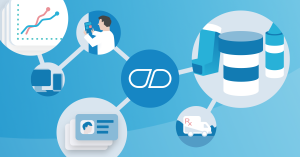The Digital Health Revolution
 COVID-19 created an accelerated path for digital health innovation across the globe, erasing the notions that physical space, time, and in-immediate access to health care are an inevitable reality. Almost overnight, so many of the old constraints were gone. Healthcare organizations, technologists, and government agencies proved that speed, innovation, and safety were indeed possible in healthcare.
COVID-19 created an accelerated path for digital health innovation across the globe, erasing the notions that physical space, time, and in-immediate access to health care are an inevitable reality. Almost overnight, so many of the old constraints were gone. Healthcare organizations, technologists, and government agencies proved that speed, innovation, and safety were indeed possible in healthcare.
Now as we look beyond COVID, it’s clear that the new innovations brought to use by the pandemic have created a new normal of what’s to come. Innovators are merging the worlds of digital-tech and healthcare to make it more accessible, breaking down the boundaries of social interaction and physical space. Applications and technology will allow patients to get effective treatment without the constant confines of a healthcare environment.
Telehealth
Telehealth has become the de-facto healthcare experience for the masses, given its ease of use and consumer-focus that enables a range of access options for patients. With telehealth, consulting a doctor can take place via video visit, phone call, or text. The COVID-19 pandemic helped to eliminate the regulations, security issues, and privacy concerns that enabled the platform to be widely used by all types of care providers.
Medical centers and insurance providers now support and encourage its use, urging patients to download apps, which enable patients to schedule appointments and consult with doctors right on their smartphones. Many people will continue to use telehealth for its convenience of doctor’s visits or therapy sessions via video; and clinics and insurers may find that it’s more cost-effective for people to receive basic care online than from in-person visits.
Remote patient monitoring
For many years the ideas of remote monitoring meant patients were saddled with a heavy device, electrodes connected to the body, capturing rhythms for irregularities. The findings weren’t evaluated until after a select period following evaluation from expert clinicians, weeks later. Through the advancement of digital technology, new patient monitoring is now capable through the advanced use of smartphones and smartwatches. A simple smartphone can now track blood pressure, heart rates, temperature, ovulation rates, blood oxygen rates, and many other stats.
Digital health has made remote patient monitoring as easy as checking email or social media engagement, able to transmit findings in real-time, with real-time readings, for faster treatment and more immediate action. This advanced connectivity enables physicians to take action sooner and eliminate the worry for patients and help them resume a more normal sense of life. As we look beyond a COVID-19 world, future versions of remote monitoring will help to detect early symptoms of future illnesses and help to prevent future outbreaks of all types.
Gamification
Gamification in healthcare is a new trend that is being used to drive engagement and activity in health behaviors. While it’s not without controversy, its inherent design uses elements of VR and AI alongside a gaming platform to reconfigure how users come to engage with health. While the idea of rewarding users for investing in something that itself delivers its own reward has some questioning its use, it creates a desire to rethink how standard health practices are delivered.
The practice of using advanced graphics and engaging platforms to connect users with their health sets a new standard for digital platforms, interoperability, and engagement. The digital health revolution has brought gamification to the masses and is likely to evolve and grow to help transform some of the more mundane and routine aspects of health to connect users and drive participation.
Digital health tools
From home delivery of prescription medication to sleek wearable electronics like the Apple Watch that can monitor an array of vital signs, healthcare has become a more consumer-oriented business. The pandemic changed every day as suddenly patients couldn’t go to a physical office to receive care. At the same time, increased social isolation made many consumers realize they had to be in charge of their own care. As a result, the role of digital health tools helped to secure a connection between patient and provider, leading to more engaged users taking an active role in their health.
Digital health tools now enable patients to monitor activity levels, nutrition, medications, and condition-specific treatments to stay on top of their health. Many digital health tools even provide updates to providers and connect with EHRs for a complete view of patient health. In the near future, patients will be able to access more of their own health information — from treatment protocols to CT scans or genomic information—will be as easily accessible as your bank balance. Digital health tools will create positive impacts on the healthcare industry with the same implications of online banking did for the financial sector.
In looking forward to a post-pandemic world, it becomes clear that a digital health revolution is well underway, helping to transform how patients, providers, and care givers engage with platforms to connect the healthcare ecosystem. Future iterations of digital investment will create additional avenues and access to put health in patients’ palms, making better health easier, efficient, and more engaging than ever before as part of a commitment to a healthier future.
